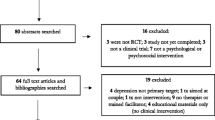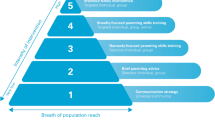Abstract
Objectives We tested the effect of nurse-delivered telephone individualized social support (“Baby BEEP”) and eight mailed prenatal smoking cessation booklets singly and in combination (2 × 2 factorial design) on smoking cessation in low-income rural pregnant women (N = 695; 75% participation). Methods Participants randomized to Baby BEEP groups (n = 345) received weekly calls throughout pregnancy plus 24-7 beeper access. Saliva cotinine samples were collected monthly from all groups by other nurses at home visits up to 6 weeks post-delivery. Primary outcomes were point prevalence abstinence (cotinine < 30 ng/ml) in late pregnancy and post-delivery. Results Only 47 women were lost to follow-up. Intent-to-treat analyses showed no difference across intervention groups (17–22%, late pregnancy; 11–13.5%, postpartum), and no difference from the controls (17%, late pregnancy; 13%, postpartum). Post hoc analyses of study completers suggested a four percentage-point advantage for the intervention groups over controls in producing early and mid-pregnancy continuous abstainers. Partner smoking had no effect on late pregnancy abstinence (OR = 1.7, 95% CI = 0.95, 3.2), but post-delivery, the effect was pronounced (OR = 3.2, 95% CI = 1.8, 5.9). Conclusions High abstinence rates in the controls indicate the power of biologic monitoring and home visits to assess stress, support, depression, and intimate partner violence; these elements plus booklets were as effective as more intensive interventions. Targeting partners who smoke is needed.

Similar content being viewed by others
References
Centers for Disease Control. (2006). Maternal and infant health: Smoking during pregnancy. Updated 10/06/2006. http://www.cdc.gov/reproductivehealth/MaternalInfantHealth/related/SmokingPregnancy.htm.
Donatelle, R., Prows, S., Champeau, D., & Hudson, D. (2000). Randomized controlled trial using social support and financial incentives for high risk pregnant smokers: Significant other supporter (SOS) program. Tobacco Control, 9(Suppl 3), iii67–iii69. doi:10.1136/tc.9.suppl_3.iii67.
Lumley, J., Oliver, S., Chamberlain, C., & Oakley, L. (2005). Interventions for promoting smoking cessation during pregnancy. The Cochrane Library: Database of Systematic Reviews, 1, 1–89.
Melvin, C., Dolan-Mullen, P., Windsor, R., Whiteside, H., & Goldenberg, R. (2000). Recommended cessation counseling for pregnant women who smoke: A review of the evidence. Tobacco Control, 9(Suppl 3), iii80–iii84.
Windsor, R., Oncken, C., Henningfield, J., Hartmann, K., & Edwards, N. (2000). Behavioral and pharmacological treatment methods for pregnant smokers: Issues for clinical practice. Journal of the American Medical Women's Association, 55(5), 304–310.
Windsor, R., Whiteside, H. P., Solomon, L., Prows, S., Donatelle, R., Cinciripini, P., et al. (2000). A process evaluation model for patient education programs for pregnant smokers. Tobacco Control, 9(Suppl 3), iii29–iii35. doi:10.1136/tc.9.suppl_3.iii29.
Orelans, C., Barker, D., Kaufman, N., & Marx, J. (2000). Helping pregnant smokers quit: Meeting the challenge in the next decade. Tobacco Control, 9(Suppl 3), iii6–iii11.
Albrecht, S. A., Rosella, J. D., & Patrick, T. (1994). Smoking among low-income, pregnant women: Prevalence rates, cessation interventions, and clinical implications. Birth, 21(3), 155–162. doi:10.1111/j.1523-536X.1994.tb00515.x.
Scheibmeir, M., & O’Connell, K. (1997). In harm’s way: Childbearing women and nicotine. JOGNN, 26, 477–484.
MMWR. (2004). Smoking during pregnancy: United States, 1990–2002. [Electronic Version], Centers for Disease Control. http://www.cdc.gov/mmwr/preview/mmwrhtml/mm5339a1.htm.
Benowitz, N., Dempsey, D., Goldenberg, R., Hughes, J., Dolan-Mullen, P., Ogburn, P., et al. (2000). The use of pharmacotherapies for smoking cessation during pregnancy. Tobacco Control, 9(suppl 3), iii91–iii94. doi:10.1136/tc.9.suppl_3.iii91.
DiClemente, C., Dolan-Mullen, P., & Windsor, R. (2000). The process of pregnancy smoking cessation: Implications for interventions. Tobacco Control, 9(Suppl 3), iii16–iii21. doi:10.1136/tc.9.suppl_3.iii16.
Ershoff, D., Solomon, L., & Dolan-Mullen, P. (2000). Predictors of intentions to stop smoking early in prenatal care. Tobacco Control, 9(Suppl 3), iii41–iii45.
Goldenberg, R., Klerman, L., Windsor, R., & Whiteside, H. P. (2000). Smoking in pregnancy: Final thoughts. Tobacco Control, 9(Suppl 3), iii85–iii86. doi:10.1136/tc.9.suppl_3.iii85.
Solomon, L., Secker-Walker, R., Flynn, B., Skelly, J., & Capeless, E. (2000). Proactive telephone peer support to help pregnant women stop smoking. Tobacco Control, 9(Suppl 3), iii72–74. doi:10.1136/tc.9.suppl_3.iii72.
Dolan-Mullen, P., DiClemente, C., Velasquez, M., Timpson, S., Groff, J., Carbonari, J., et al. (2000). Enhanced prenatal case management for low income smokers. Tobacco Control, 9(Suppl III), iii75–iii-77.
Dolan-Mullen, P. D., DiClemente, C., & Velasquez, M. (2000). Theory and context and project PANDA: A program to help post-partum women stay off cigarettes. In L. K. Bartholomew, G. Parcel, G. Kok, & H. Gottlieb (Eds.), Designing theory and evidence-based health promotion programs (pp. 453–477). Mountain View, CA: Mayfield Publishers.
Ershoff, D., Quinn, V., Boyd, N., Stern, J., Gregory, M., & Wirtschafter, D. (1999). The Kaiser Permanente prenatal smoking cessation trial. When more isn’t better, what is enough? American Journal of Preventive Medicine, 17(3), 161–168. doi:10.1016/S0749-3797(99)00071-9.
Treating Tobacco Use Dependence Clinical Practice Guideline PanelStaff Consortium Representatives. (2000). A clinical practice guideline for treating tobacco use and dependence: A US Public Health Service report. JAMA, 283(24), 3244–3254. doi:10.1001/jama.283.24.3244.
Hodnett, E. D., & Fredericks, S. (2003). Support during pregnancy for women at increased risk of low birthweight babies. Cochrane Database of Systematic Reviews, Issue 3. Art No.: CD000198.CD000198.
Bullock, L. F. C. (1996). Effect of a low-cost health promotion program for pregnant women. Unpublished doctoral dissertation. University of Otago, Christchurch, New Zealand.
Bullock, L. F. C., Wells, J. E., Duff, G. B., & Hornblow, A. R. (1995). Telephone support for pregnant women. New Zealand Medical Journal, 108, 190–192.
Oakley, A. (1994). In S. Robinson & A. Thompson (Eds.), Midwives research and childbirth (Vol. 3, pp. 30–63). London: Chapman and Hall.
Ershoff, D., Dolan-Mullen, P., & Quinn, V. (1989). A randomized trial of a serialized self-help smoking cessation program for pregnant women in an HMO. American Journal of Public Health, 79, 182–187.
Windsor, R. A., Lowe, J. B., Perkins, L. L., Smith-Yoder, D., Artz, L., Crawford, M., et al. (1993). Health education for pregnant smokers: Its behavioral impact and cost benefit. American Journal of Public Health, 83, 201–206.
Cohen, S., Kamarck, T., & Mermelstein, R. (1983). A global measure of perceived stress. Journal of Health and Social Behavior, 24(4), 385–396. doi:10.2307/2136404.
Cohen, S., & Williamson, G. (1988). Perceived stress in a probability sample of the United States. In S. Spacapan & S. Oskap (Eds.), The social psychology of health: The claremont symposium on applied social psychology (pp. 31–67). Thousand Oaks: Sage Publications.
Cohen, S., & Lichtenstein, E. (1990). Perceived stress, quitting smoking, and smoking relapse. Health Psychology, 9(4), 466–478. doi:10.1037/0278-6133.9.4.466.
Curry, M. A., Campbell, R. A., & Christian, M. (1994). Validity and reliability testing of the prenatal psychosocial profile. Research in Nursing and Health, 17, 127–135. doi:10.1002/nur.4770170208.
Curry, M. A., Burton, D., & Fields, J. (1998). The Prenatal Psychosocial Profile: A research and clinical tool. Research In Nursing and Health, 21, 211–219. doi: 10.1002/(SICI)1098-240X(199806)21:3<211::AID-NUR4>3.0.CO;2-K.
Berwick, D., Murphy, J., Goldman, P., Ware, J., Barsky, A., & Weinstein, M. (1991). Performance of a five-item mental health screening test. Medical Care, 29, 169–176. doi:10.1097/00005650-199102000-00008.
Manne, S., & Schnoll, R. (2001). Measuring cancer patients’ psychological distress and well-being: A factor analytic assessment of the Mental Health Inventory. Psychological Assessment, 13, 99–109. doi:10.1037/1040-3590.13.1.99.
Rumpf, H., Meyer, C., Hapke, U., & John, U. (2001). Screening for mental health: Validity of the MHI-5 using DSM-IV Axis I psychiatric disorders as gold standard. Psychiatry Research, 105, 243–253. doi:10.1016/S0165-1781(01)00329-8.
Heatherton, T. F., Kozlowski, L. T., Frecker, R. C., & Fagerstrom, K. (1991). The Fagerstrom Test for nicotine dependency: A revision of the Fagerstrom tolerance questionnaire. British Journal of Addiction, 86, 1119–1127. doi:10.1111/j.1360-0443.1991.tb01879.x.
Moher, D., Schulz, K., & Altman, D. (2001). The CONSORT statement: Revised recommendations for improving the quality of reports of parallel group randomized trials. BMC Medical Research Methodology, 1, 2. doi:10.1186/1471-2288-1-2.
Boutron, I., Moher, D., Altman, D. G., Schulz, K. F., & Ravaud, P. (2008). Extending the CONSORT statement to randomized trials of nonpharmacologic treatment: Explanation and elaboration. Annals of Internal Medicine, 148, 295–309.
Hartmann, K., Thorp, J., Pahel-Short, L., & Koch, M. (1996). A randomized controlled trial of smoking cessation intervention in pregnancy in an academic clinic. Obstetrics & Gynecology, 87, 621–626. doi:10.1016/0029-7844(95)00492-0.
Hughes, E., Lamont, D., Beecroft, M., Wilson, D., Brennan, B., & Rice, S. (2000). Randomized trial of a “stage-of-change” oriented smoking cessation intervention in infertile and pregnant women. Fertility and Sterility, 74(3), 498–503. doi:10.1016/S0015-0282(00)00687-7.
Windsor, R. A., Cutter, G., Morris, J., Reese, Y., Manzella, B., Bartlett, E. E., et al. (1985). The effectiveness of smoking cessation methods for smokers in public health maternity clinics: A randomized trial. American Journal of Public Health, 75, 1389–1392.
Secker-Walker, R., Solomon, L., Flynn, B., Skelly, J., & Mead, P. (1997). Modeling smoking cessation: Exploring the use of a videotape to help pregnant women quit smoking. Women & Health, 25, 23–35. doi:10.1300/J013v25n01_02.
Appleton, P. L., & Pharoah, P. O. (1998). Partner smoking behaviour change is associated with women’s smoking reduction and cessation during pregnancy. British Journal of Health Psychology, 3, 361–374.
Haug, K., Aaro, L. E., & Fugelli, P. (1992). Smoking habits in early pregnancy and attitudes towards smoking cessation among pregnant women and their partners. Family Practice, 9, 494–499. doi:10.1093/fampra/9.4.494.
Holmes, C. (2001). Partner involvement in smoking cessation. British Journal of Midwifery, 9, 357–361.
Mullen, P. (2004). How can more smoking suspension during pregnancy become lifelong abstinence? Lessons learned about predictors, interventions, and gaps in our accumulated knowledge. Nicotine & Tobacco Research, 6(2), S217–S238. doi:10.1080/14622200410001669150.
Nafstad, P., Botten, G., & Hagen, J. (1996). Partner’s smoking: A major determinant for changes in women’s smoking behaviour during and after pregnancy. Public Health, 110, 379–385. doi:10.1016/S0033-3506(96)80012-6.
Enrenius, K., Axelsson, O., & Sjoden, P. (1996). Pregnancy, ultrasound screening and smoking attitudes. Gynecologic and Obstetric Investigation, 42, 73–76.
McBride, C., Baucom, D., Peterson, B., Pollak, K., Palmer, C., & Westman, E. (2004). Prenatal and postpartum smoking abstinence. A partner-assisted approach. American Journal of Preventive Medicine, 27, 232–238.
Mullen, P., DiClemente, C., & Bartholomew, L. (2000). Theory and context and project PANDA: A program to help postpartum women stay off cigarettes. In L. K. Bartholomew, G. S. Parcel, G. Kok, & H. Gottlieb (Eds.), Designing theory and evidence-based health promotion programs (pp. 453–477). Mountain View, California: Mayfield Publishers.
Pollak, K. I., McBride, C. M., Baucom, D. H., Curry, S. J., Lando, H., Pirie, P. L., et al. (2001). Women’s perceived and partner’s reported support for smoking cessation during pregnancy. Annals of Behavioral Medicine, 23, 208–214. doi:10.1207/S15324796ABM2303_8.
Stanton, W. R., Love, J. B., Moffatt, J., & Del Mar, C. B. (2004). Randomised control trial of a smoking cessation intervention directed at men whose partners are pregnant. Preventive Medicine, 38, 6–9. doi:10.1016/j.ypmed.2003.09.021.
Wakefield, M., Reid, Y., Roberts, L., Mullins, R., & Gilles, P. (1998). Smoking and smoking cessation among men whose partners are pregnant: A qualitative study. Social Science & Medicine, 47, 657–664. doi:10.1016/S0277-9536(98)00142-7.
Gage, J. (2005). Male partner participation in smoking cessation of women during pregnancy: Fatherhood as motivator for smoking behavior change. Unpublished doctoral dissertation. University of Missouri, Columbia.
DHHS (Department of Health Human Services). (2000). Clinical practice guideline: Treating tobacco use and dependence. Washington, DC: U.S. Government Printing Office.
Acknowledgments
The project described was supported by Grant Number R01NR05313 from the National Institute of Nursing Research. The content is solely the responsibility of the authors and does not necessarily represent the official views of the National Institute of Nursing Research or the National Institute of Health. Support for development and reproduction of the smoking cessation booklets was provided by the Division of Lung Diseases-National Heart, Lung, and Blood Institute; the University Of Texas School of Public Health; and the Agency for Health Care Policy and Research. A very special thanks goes to the Baby BEEP research team: Alette Comstock, RN, Jan Davis, RN, Jeffrey Gage, RN, PhD, Natalie McGrath, RN, Mandy Manderino, PhD, RN, Karen Rupright, RN, Barbara Tanner, RN, Richard Tayloe, and Karry Young, RN. Also a special thanks to the personnel at the 21 participating WIC clinics and of course, to all the women who agreed to participate in this trial.
Author information
Authors and Affiliations
Corresponding author
Rights and permissions
About this article
Cite this article
Bullock, L., Everett, K.D., Mullen, P.D. et al. Baby BEEP: A Randomized Controlled Trial of Nurses’ Individualized Social Support for Poor Rural Pregnant Smokers. Matern Child Health J 13, 395–406 (2009). https://doi.org/10.1007/s10995-008-0363-z
Received:
Accepted:
Published:
Issue Date:
DOI: https://doi.org/10.1007/s10995-008-0363-z




